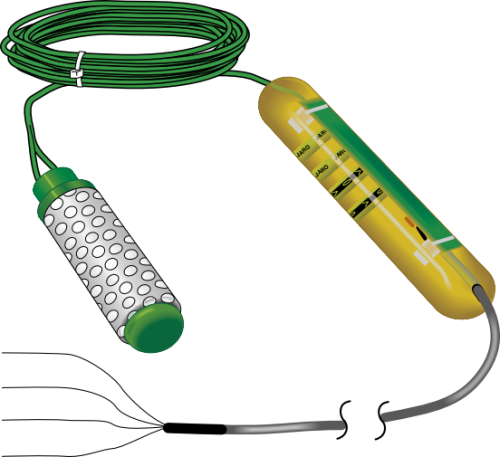
No maintenance required






Overview
The 257, manfuactured by Watermark, is a solid-state, electrical-resistance sensing device with a granular matrix that estimates soil water potential from 0 to -200 kPa (typically wetter or irrigated soils). It connects directly to your data logger.
Read MoreBenefits and Features
- Survives freeze-thaw cycles
- Compatible with most Campbell Scientific data loggers
- Contains blocking capacitors in its cable that minimize galvanic degradation and measurement errors due to ground loops
- Buffers salts in soil
- Rugged, long-lasting sensor
Images

Similar Products
Detailed Description
When the amount of water in the soil surrounding the sensor changes, a difference in water potential between the soil and the sensor material is established. This gradient in potential causes a water flux between the two materials. For example, an irrigation or precipitation event results in movement of soil water into the 257 until equilibrium in water potential between the sensor and the soil occurs. An increase in the amount of water in the sensor reduces the electrical resistance between the sensor electrodes.
The data logger measures the resistance between electrodes, and then converts the resistance measurement to soil water potential by using calibration values supplied with the sensor.
The 257 consists of two concentric electrodes embedded in a reference matrix material. The matrix material is surrounded by a synthetic membrane for protection against deterioration. An internal gypsum tablet buffers against the salinity levels found in irrigated soils. The cable jacket is made of Santoprene rubber, which is resistant to temperature extremes, water, and UV degradation.
The 257's construction can allow the sensor (in some circumstances) to be left in the soil all year, eliminating the need to remove the sensor during fallow periods.
Compatibility
Specifications
| Measurement Range | 0 to -200 kPa |
| Diameter | 1.91 cm (0.75 in.) |
| Length | 8.26 cm (3.25 in.) |
| Weight | 360 g (0.8 lb) |
Documents
Frequently Asked Questions
Number of FAQs related to 257-L: 3
Expand AllCollapse All
-
Not every sensor has different cable termination options. The options available for a particular sensor can be checked by looking in two places in the Ordering information area of the sensor product page:
- Model number
- Cable Termination Options list
If a sensor is offered in an –ET, –ETM, –LC, –LQ, or –QD version, that option’s availability is reflected in the sensor model number. For example, the 034B is offered as the 034B-ET, 034B-ETM, 034B-LC, 034B-LQ, and 034B-QD.
All of the other cable termination options, if available, are listed on the Ordering information area of the sensor product page under “Cable Termination Options.” For example, the 034B-L Wind Set is offered with the –CWS, –PT, and –PW options, as shown in the Ordering information area of the 034B-L product page.
Note: As newer products are added to our inventory, typically, we will list multiple cable termination options under a single sensor model rather than creating multiple model numbers. For example, the HC2S3-L has a –C cable termination option for connecting it to a CS110 instead of offering an HC2S3-LC model.
-
Most Campbell Scientific sensors are available as an –L, which indicates a user-specified cable length. If a sensor is listed as an –LX model (where “X” is some other character), that sensor’s cable has a user-specified length, but it terminates with a specific connector for a unique system:
- An –LC model has a user-specified cable length for connection to an ET107, CS110, or retired Metdata1.
- An –LQ model has a user-specified cable length for connection to a RAWS-P weather station.
If a sensor does not have an –L or other –LX designation after the main model number, the sensor has a set cable length. The cable length is listed at the end of the Description field in the product’s Ordering information. For example, the 034B-ET model has a description of “Met One Wind Set for ET Station, 67 inch Cable.” Products with a set cable length terminate, as a default, with pigtails.
If a cable terminates with a special connector for a unique system, the end of the model number designates which system. For example, the 034B-ET model designates the sensor as a 034B for an ET107 system.
- –ET models terminate with the connector for an ET107 weather station.
- –ETM models terminate with the connector for an ET107 weather station, but they also include a special system mounting, which is often convenient when purchasing a replacement part.
- –QD models terminate with the connector for a RAWS-F Quick Deployment Station.
- –PW models terminate with the connector for a PWENC or pre-wired system.
-
Many Campbell Scientific sensors are available with different cable termination options. These options include the following:
- The –PT (–PT w/Tinned Wires) option is the default option and does not display on the product line as the other options do. The cable terminates in pigtails that connect directly to a data logger.
- In the –C (–C w/ET/CS110 Connector) option, the cable terminates in a connector that attaches to a CS110 Electric Field Meter or an ET-series weather station.
- In the –CWS (–CWS w/CWS900 Connector) option, the cable terminates in a connector that attaches to a CWS900-series interface. Connection to a CWS900-series interface allows the sensor to be used in a wireless sensor network.
- In the –PW (–PW w/Pre-Wire Connector) option, the cable terminates in a connector that attaches to a prewired enclosure.
- In the –RQ (–RQ w/RAWS Connector) option, the cable terminates in a connector that attaches to a RAWS-P Permanent Remote Automated Weather Station.
Note: The availability of cable termination options varies by sensor. For example, sensors may have none, two, or several options to choose from. If a desired option is not listed for a specific sensor, contact Campbell Scientific for assistance.
Privacy Policy Update
We've updated our privacy policy. Learn More
Cookie Consent
Update your cookie preferences. Update Cookie Preferences
